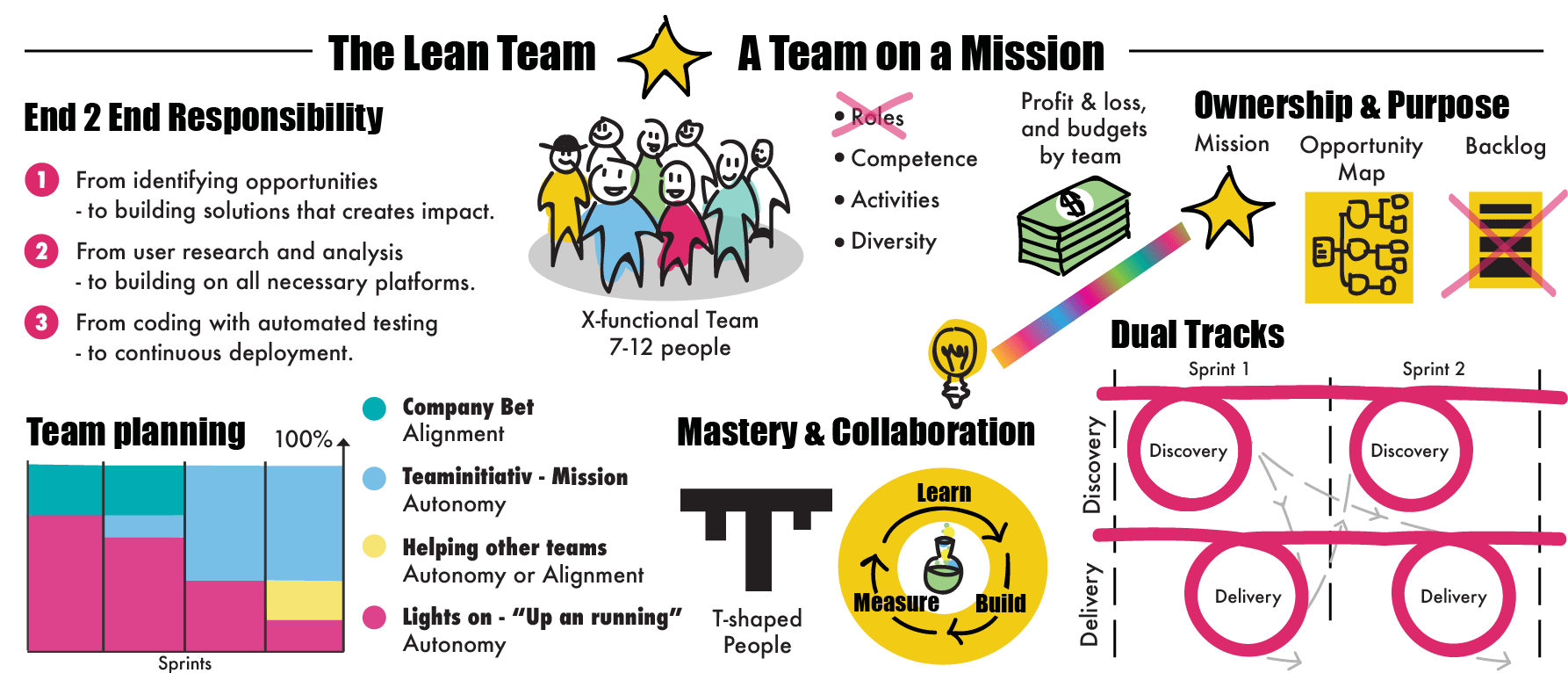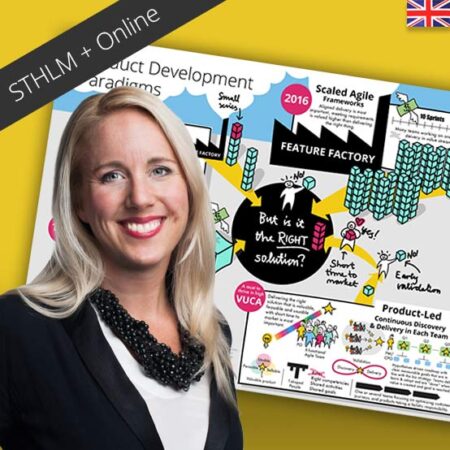Since the customer is what drives the value in the organization, we must also organize accordingly. Narrow minded, sub-optimized-silos-days are finally over – future proof organizations with teams that have customer focus and can use their brain power to deliver value – here we come!
Poster downloads (PDF):
English version of the poster >
Brazilian Portuguese version of the poster >
French version of the poster >
Spanish version of the poster >
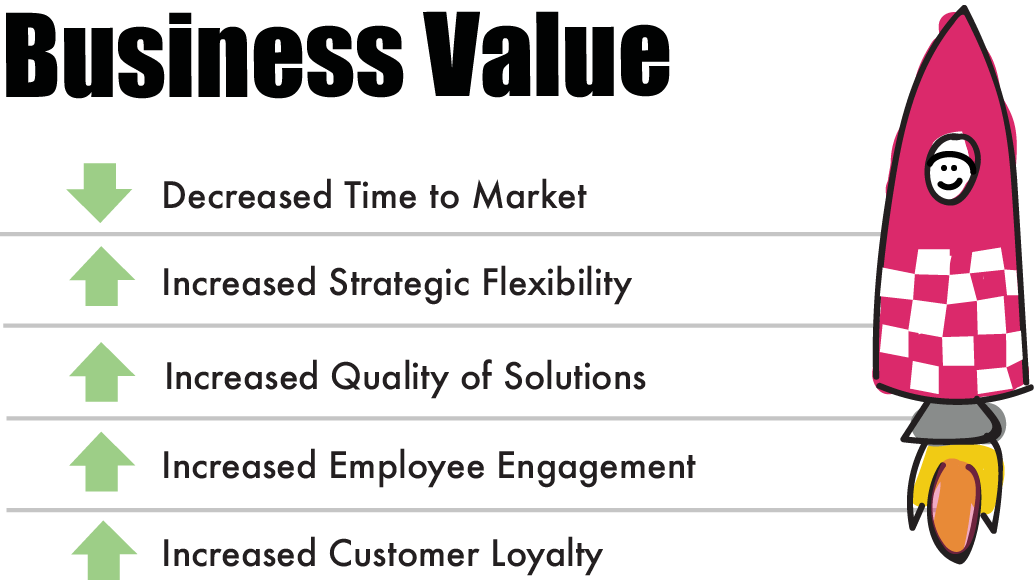 To organize around the customer journey has proven to be extremely effective in order to deliver as much value as possible, as fast as possible – and to make the customer as well as the employees feel awesome! In most organization the organization structure itself is what´s causing the most pain – maybe no wonder when you reflect on that the silos based hierarchical organization is over 100 years old! You can download the Agile Leadership poster for more on that topic.
To organize around the customer journey has proven to be extremely effective in order to deliver as much value as possible, as fast as possible – and to make the customer as well as the employees feel awesome! In most organization the organization structure itself is what´s causing the most pain – maybe no wonder when you reflect on that the silos based hierarchical organization is over 100 years old! You can download the Agile Leadership poster for more on that topic.
We are starting to see great results from organizations that have embraced this that makes for a strong business case for any organization. We love to be able to finally be able to share this concept with you. Enjoy!
The Over all Structure of the Customer Journey Product Organization
We have captured the over all visualization of how the organization can work hoping to give you a goal picture and a common understanding.
Here you can Download the poster in high resolution (PDF) >
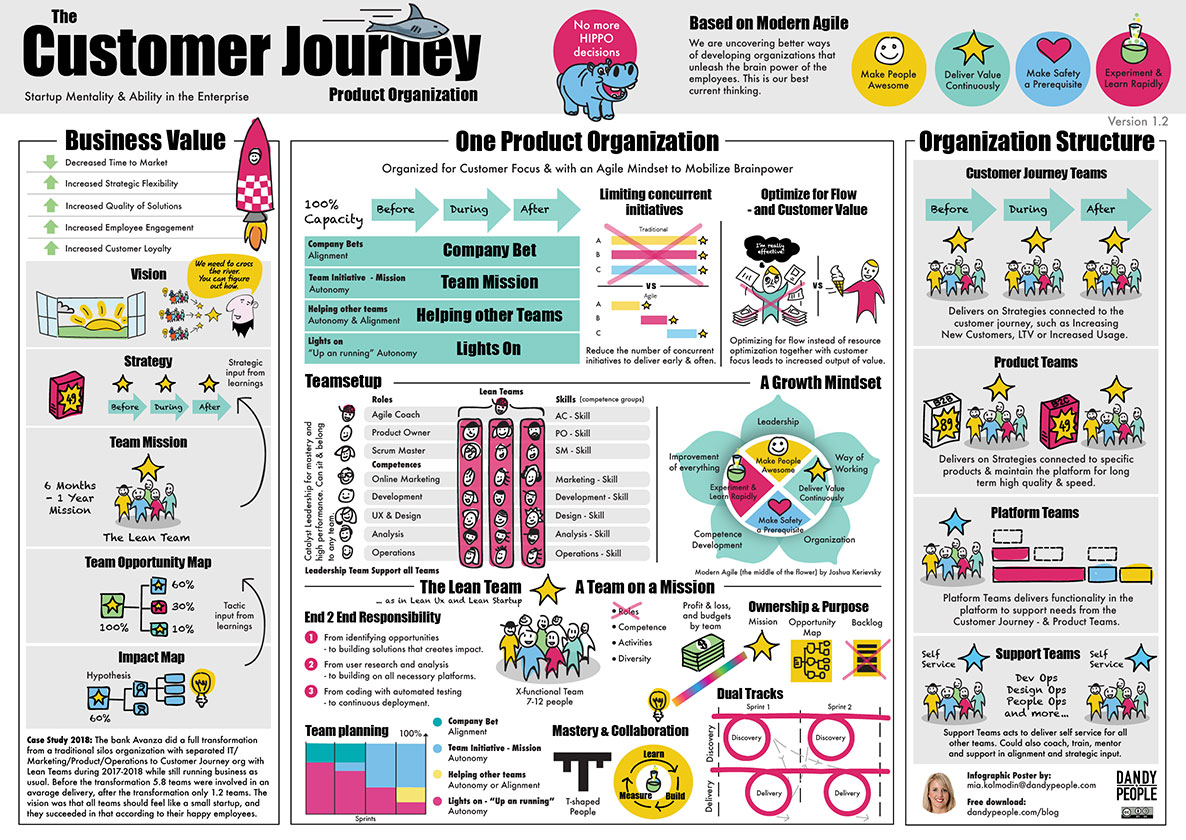 At Dandy People we support teams and organizations to become Agile to be able to focus on the business strategies and to mobilize the brain power in the teams to deliver value continuously. We call these value driven Agile teams for “Lean Teams” since they own the process end 2 end to deliver value, and that they also own the part of the service or product end 2 end. These teams work hypothesis based and have clear missions for 6-12 months with clear KPIs that gives them mandate to decide what to do when and enables them to have a ongoing learning process – all which is needed in a fast paced world if you desire to be the leading product or service within your niche. Crucial for these teams are of course the T-shape of the team members. The T-shape is something that enables the team to work as a team and it creates a really strong teams without dependencies to people within the team – and it also prevents the team to not do mini-waterfall in the team (just doing their part and handing over to the next). You can read more about T-shape here and how to grow it as a leader.
At Dandy People we support teams and organizations to become Agile to be able to focus on the business strategies and to mobilize the brain power in the teams to deliver value continuously. We call these value driven Agile teams for “Lean Teams” since they own the process end 2 end to deliver value, and that they also own the part of the service or product end 2 end. These teams work hypothesis based and have clear missions for 6-12 months with clear KPIs that gives them mandate to decide what to do when and enables them to have a ongoing learning process – all which is needed in a fast paced world if you desire to be the leading product or service within your niche. Crucial for these teams are of course the T-shape of the team members. The T-shape is something that enables the team to work as a team and it creates a really strong teams without dependencies to people within the team – and it also prevents the team to not do mini-waterfall in the team (just doing their part and handing over to the next). You can read more about T-shape here and how to grow it as a leader.
In this post you can download the poster for free and learn more about:
- Lean Teams Connected to the Customer Journey with Missions
- User research, Planning and Delivery across the Organization – connects as never before
- Slicing for Value with User Story Mapping to create Alignment
- The different type of teams
- Cross-functional competences is needed in the Lean Team
- Modern Agile and Continuous improvement of the System
- Choosing what type of Organization you want to have Together
- Avanza Leads the way with Lean Teams and Customer Journey Organization
- Presentation on the Customer Journey Product Organization
Lean Teams Connected to the Customer Journey with Missions
The Lean Teams (as in Lean UX and Lean Startup) are connected to the most important business strategies via the customer journey – or they take ownership of specific products. These teams will need support from other teams, such as a platform team and support teams who’s mission is to support the needs from the Lean Teams and when needed enable self service so the Lean Teams can work as independently as possible delivering fast with high quality. This makes the organization and the teams fast at delivering whats needed, when it´s needed without having to have someone to tell them what to do when. “Lean” in Lean Team also refers to Lean UX and Lean Startup, the team works with both discovery AND delivery end to end to always learn what solutions are needed, with a long term mission, they can stop delivering on one idea when they see a change on connecting KPI´s and move on to the next thing that now is the most important opportunity. This approach creates truly high performing team with all skills needed, that can work really well together in all different parts of the process as well as great product ownership (as in the process).
Many organizations will have to start to transform from a silos based organization to cross functional Lean Teams – and that journey must start both top down and bottom up. If the leadership (management) don’t enable this and start changing the system surrounding the teams, the people in the teams will not be able to do the changes needed.
User research, Planning and Delivery across the Organization – connects as never before
 The Customer Journey Product Organization with Lean Teams is a way to scale an organization to support customer focus, agile mindset and principles – increasing speed AND value to the max. This type of organization done well, is always on it´s toes to understand and learn about the users needs, experimenting and learning about new behaviors, as well as taking car of existing customers. The Customer Journey organization format is by default well connected with user research methods such as Service Design, Customer Journey Mapping and Design Thinking enabling the teams to align as well keeping the teams autonomous. To plan the work needed to solve customer pain points found in the user research (in the customer journey) the organization can easily use User Story Mapping to plan all the work needed across the organization in a visual and adaptive way to enable agile sliced deliveries based on customer scenarios. This is the wet dream for any control freak – so yes, you too should get super exited. No more worries about if the organization is working on the right things. This way of working will save the organization so much work not having to do any project management, not doing any reports on progress (because that is visual to everyone in the organization on storysonboard.com) or doing any estimates with story points (if the teams don´t want too). Visualization like this gives focus and enables collaboration to solve tricky customer problems in complex technical and restricted domains. If you once have worked like this, I can promise you never wan´t to go back to any other way of working. Here you can download the Agile User Experience poster for free for more on this topic.
The Customer Journey Product Organization with Lean Teams is a way to scale an organization to support customer focus, agile mindset and principles – increasing speed AND value to the max. This type of organization done well, is always on it´s toes to understand and learn about the users needs, experimenting and learning about new behaviors, as well as taking car of existing customers. The Customer Journey organization format is by default well connected with user research methods such as Service Design, Customer Journey Mapping and Design Thinking enabling the teams to align as well keeping the teams autonomous. To plan the work needed to solve customer pain points found in the user research (in the customer journey) the organization can easily use User Story Mapping to plan all the work needed across the organization in a visual and adaptive way to enable agile sliced deliveries based on customer scenarios. This is the wet dream for any control freak – so yes, you too should get super exited. No more worries about if the organization is working on the right things. This way of working will save the organization so much work not having to do any project management, not doing any reports on progress (because that is visual to everyone in the organization on storysonboard.com) or doing any estimates with story points (if the teams don´t want too). Visualization like this gives focus and enables collaboration to solve tricky customer problems in complex technical and restricted domains. If you once have worked like this, I can promise you never wan´t to go back to any other way of working. Here you can download the Agile User Experience poster for free for more on this topic.
Slicing for Value with User Story Mapping to create Alignment
The User Scenario is the core in the Customer Journey – we tell the story of the user. The Scenarios are the base for the planning. All scenarios belong to a role or a persona. This helps to understand the context, as well as to slice for value. The same scenarios are also used as a base for testing.
The Backbone of the User Story Map goes across the timeline. Its the high level process, usually it stays the same year after year, the only thing that changes is the solution in how we serve our customers.
User Story Mapping is a method created by Jeff Patton. It can be digitzed in storiesonboard.com and imported slice by slice to Trello or Jira if needed still keeping the big picture intact.
When working like this it´s easy for the team to get an overview of what they are delivering on as a team, but also across teams. Make sure to involve the teams in creating the user story map too so that you can use their brain power in actually solving the user problems and finding the best solutions doing so, then everyone knows why they are doing what and for who, and they can all help out to make smart tactical and operational decisions.
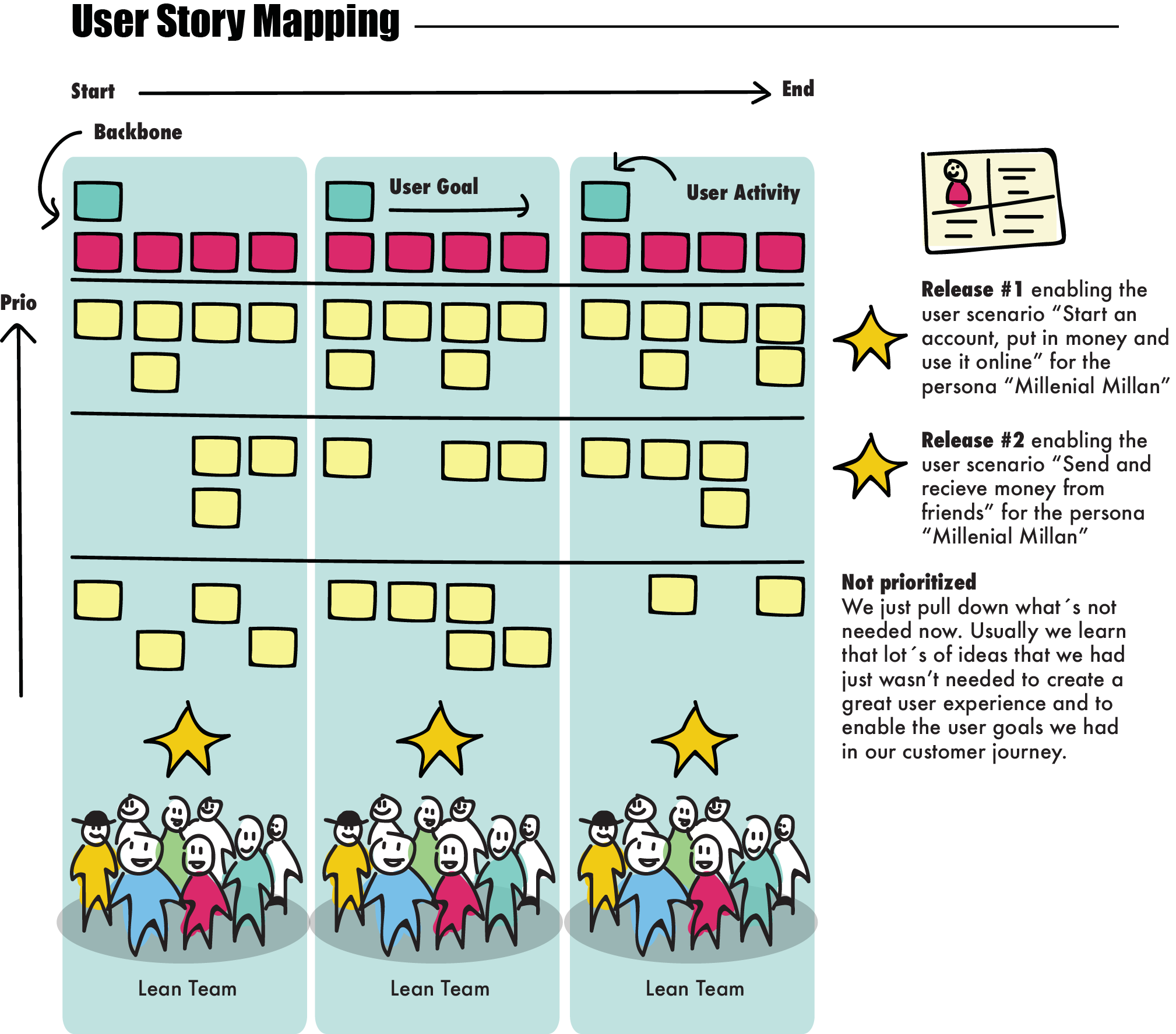
The different type of teams
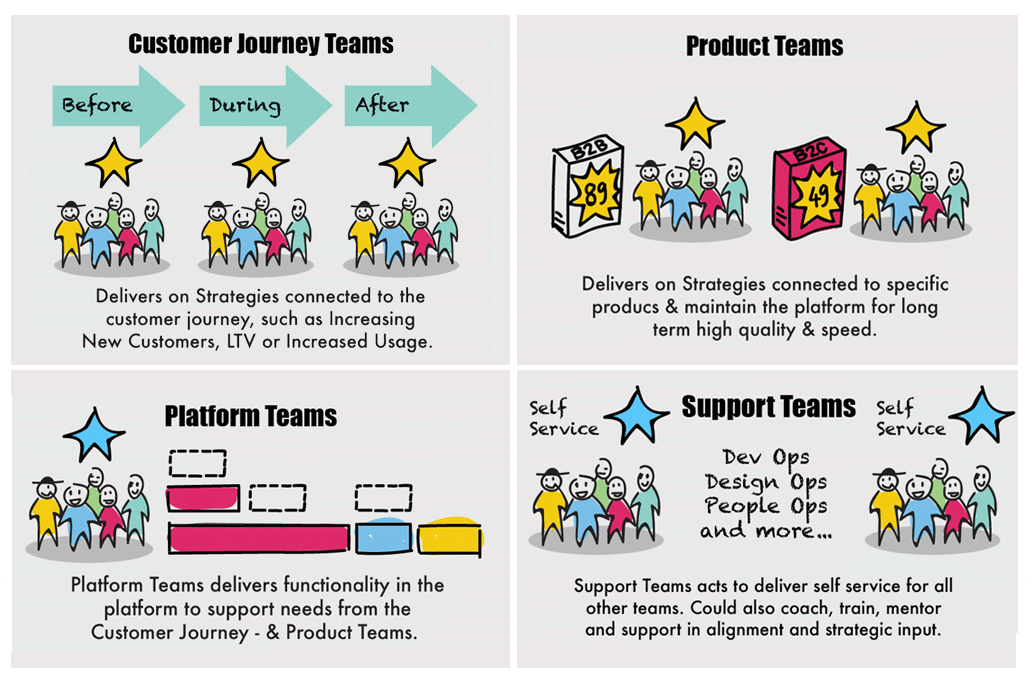
- Customer Journey Teams – Delivers on Strategies connected to the customer journey, such as Increasing New Customers, LTV or Increased Usage.
- Product Teams – Delivers on Strategies connected to specific products & maintain the platform for long term high quality & speed.
- Platform Teams – Platform Teams delivers functionality in the platform to support needs from the Customer Journey – & Product Teams.
- Support Teams – Support Teams acts to deliver self service for all other teams. Could also coach, train, mentor and support in alignment and strategic input.
Cross-functional competences is needed in the Lean Team

The competences needed in a Lean Team is based on what Mission the team has. It will differ from team to team, and from organization to organization. Compared with a traditional silos organization, this organization is a matrix organization. It might not even be needed to do a “re-organization” to shift to this organization. Of course you have to change who you sit and work with, but you might could keep the same manager. Managers who take care of the people are preferably put within a “skill”.
Since the team in “on a Mission” they need to be really great at team work. Therefore roles and titles are usually removed from the team. What´s is important is to solve the mission together, not who is doing what. This creates the environment for really high performance teams. The roles in a Lean Team (just as in a normal Scrum Team) is the Product Owner, The Scrum Master (yes, you probably still will work in Scrum) and then, all the rest is simply – the team. The Scrum Master Role might though be a rotating “hat”, meaning the team might have several team members that can act as Scrum Master and rotate as they like. Perhaps these teams also might come up with new “hats” or in the future. Since Lean UX and Design Thinking together with facilitation skills will be highly important for these teams, that might also be a “hat” in the team to be able to coach and facilitate these activities in the team.
The Managers job is first of all to take care of the needs of the people and supporting the skill to learn from each other between the teams, gain new knowledge and to remove obstacles for the teams to enable mastery and high performance. The manager in a skill does not need to be expert herself within that area of expertise but rather have a growth mindset, helping people to grow and support them when they need support outside the team. The manager does not have anything to do with WHY, WHAT or HOW the teams do their product development work. Having managers horizontally across teams makes it easier for team members to join new teams, otherwise the employees need to change manager to move between teams, and that usually makes the organization less flexible over time. Also it makes the transformation from a traditional organization more smooth.
The Manager too belong to a team, the Leadership Team, having stand-ups and working to always improve the system in the organization. In the long run though, the role of the Leadership Team can perhaps grow in to a Agile coaching unit that coaches in between teams and supports in removing impediments outside the team. But then there need to be support teams to supporting the full needs of the teams, or the teams take on those tasks as well. You should always view it as an emerging process, start where you are at and work together to create a safe environment, mobilize the brain power in the organization and improve as you go along.
Support Teams
If the teams are in need of more support within a specific skill a support team should be created. Such a support teams Mission is to enable self service to the teams, to support in competence development across all teams and to improve what´s going on “in-between-teams”. An example on such a team could be Design Ops.
Example of a mission for a Design Ops Team
“We make it easy for all Teams to see the “big picture” for the customer, to quickly create usable design on all platforms and to support an aligned user experience across teams”.
Example of activities for a Design Ops Team
- Create and update design framework to align the user experience and make it easier for the teams
- Visualize data and insights from all teams
- Coach and train all teams and leaders in design activities and skill set if needed
- Input and support for Strategic Company Bets or to teams when needed
Modern Agile and Continuous improvement of the System
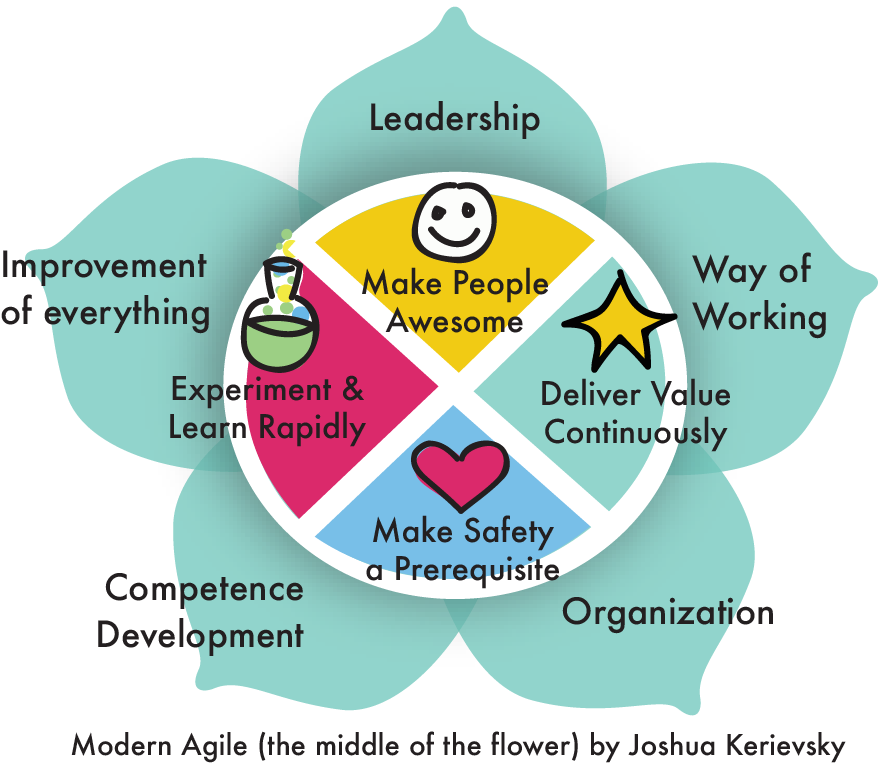 The values of Modern Agile works really well with this type of customer focused organization and with the way of working in the Lean Teams. Lean teams will not work without the 4 values in place.
The values of Modern Agile works really well with this type of customer focused organization and with the way of working in the Lean Teams. Lean teams will not work without the 4 values in place.
Modern Agile together with the Lean Team concept also gives a freshness to the view on Agile that can be needed in many organizations today who might have been struggling with making the Scrum Teams on IT work smoothly with the customer.
At Dandy People we created a visualization around Modern Agile to make it easier for Leaders to see how they can apply this in their daily work to enable the values of Modern Agile. We call it the Modern Agile Flower. It aims to show the big picture from a leadership perspective.
What the organization need to focus on to enable Modern Agile is:
– Leadership
– Way of Working
– Organization
– Competence Development
– Improvement of Everything
Choosing what type of Organization you want to have Together
About a year and half ago we had a couple of workshops together with Avanza where we supported them in creating an understanding about the different type of organizations you can have, how they work and how the different ways to organize would affect their own deliveries. We had about 35-40 people signing up and joining in doing experienced based learnings and theory to enable them to make the decision together. They visualized their customer journey and all their products together as a basis for shared knowledge. One of the things we also did was to facilitate a session where they came up with 7 guiding principles on how they wanted their perfect organization to work. The day after we used these guiding principles to evaluate how well their current organization would perform in delivering 3 different type of common deliveries. The different type of organizations evaluated was value stream based, customer journey based and component team based organization – as well as their current silos based. All work was done in small cross functional groups: We could see that all groups thought that their current organization performed really bad on all principles as well on all deliveries, and that customer journey based organization with Lean Teams would be the best 🙂 Here you can rad about the specific workshop where they compared the different organizations >
Avanza Leads the way with Lean Teams and Customer Journey Organization
Now we have also seen the results at one of our lovely and brave clients, Avanza (FinTech product company), who has managed to do this. They have reached their vision with the change, that the team feels like they are a startup! Avanza recently shared their story on how they managed to do the transformation at a meet-up in their office here in Stockholm. They have also shared the video from the presentation which you can watch here too (thank you every one at Avanza, we love you!). They have gone from having a normal organization with Marketing, IT, Product, Operations in separate silos giving them too long lead times and inability to deliver value as they wanted, having and average of 5.8 teams involved in a normal release – to now after the transformation only 1.2 teams! This is truly amazing since it means these teams can truly deliver customer value end to end without dependencies. The organization now has Lean Teams that are truly cross-functional, that work with Lean UX having as short feedback loops as possible and the mandate to deliver what they find valuable to the customer based on the teams mission. Employee happiness index too has gone up and people feel much more engaged.
Presentation on the Customer Journey Product Organization
The presentation that I have had around this topic “Customer focus with an Agile mindset” is describing why old organizations with silos cant deliver value any more, why that is, and what you can do about it. I talk about how to go from being a snail to becoming a shark. The seminar has been very popular with fully booked monthly breakfast seminars at our HQ in Stockholm for over a year as well as talks at conferences such as Agile Days Istanbul, Agila Örebro, Sundsvall 42 and Agile Islands. I´ve also been invited to speak internally at organizations across Sweden to inspire and give new perspectives of what Agility means for the entire organization, on a organizational as well as strategic level, and what leadership is needed to support this. This is clear signals on how important this is for many organizations right now. Here you can watch the presentation live from Agila Örebro (Swedish) >
Here you find all the other posters in the series that are now translated to 14 languages and downloaded over 70.000 times world wide.
